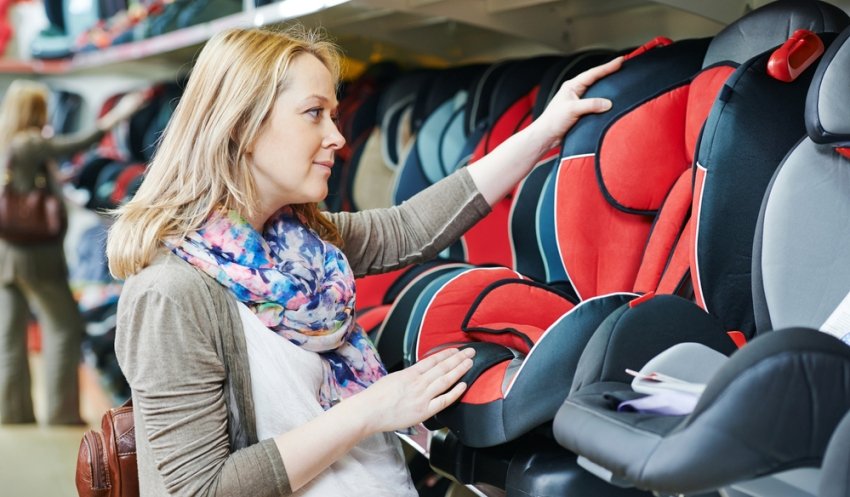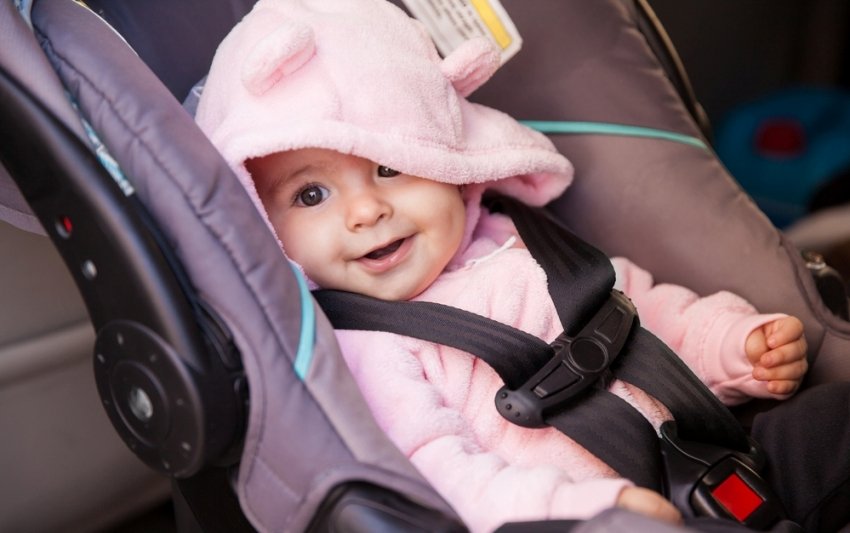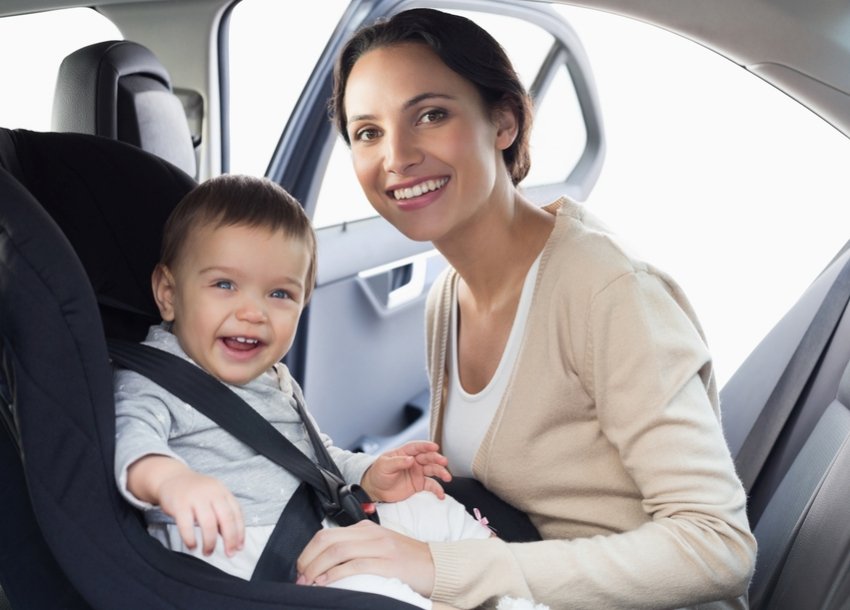Before you have your baby, you’ll wind up buying a new car seat. Hospital policy states that your little one has a car seat before leaving the hospital. This may vary depending on location, but it is the policy in Ohio.
Plenty of options are available for parents buying a car seat, like used, brand new, etc. In addition to that, there are hundreds of car seats available on the market.
The most important thing to consider when buying a car seat and using it is car seat safety guidelines. Guidelines are in place for children up until they are out of both a car seat and a booster seat.
These are designed to keep children safe, but there are so many that it can get confusing. Here is what parents need to know.
In this article
Why Are Car Seat Safety Guidelines Important?
According to statistics, children in car seats are almost 80% less likely to be injured if they are involved in a car accident. They are nearly 30% less likely to die in a vehicle accident.
This is because car seats provide additional protection that small children need, such as the padding around their heads.
Booster seats play a role in keeping children safe, too. These make older children sit up higher in the car so that the seat belt fits properly.
If they are not tall enough to sit in a car without a booster seat, yet you do it anyway, you’ll notice that the seat belt is up against their neck instead of across their chest where it should be.
If a car accident occurs, this can result in the seat belt cutting through their skin.
View in gallery
Complying With The Law
Not only do car seats keep children safe, but it is also illegal to have a child in the car without a car seat. All states have car seat laws. Parents that refuse to abide by these laws can face criminal charges, including child endangerment charges.
The penalty, if found guilty can result in a fine, or jail time. Parents that are involved in a car accident that results in a fatality can face more severe charges if their child is not in a child restraint.
Car Seat Safety Guidelines By State
In one state, children must sit in the backseat, but two-seater cars are exempt from this law. In other states, two-seater cars are not mentioned.
Different states also provide different requirements pertaining to booster seats and forward-facing car seats.
Because of the differences, it’s important to make sure that you get accurate information regarding the state that you live in. Here is a list of safety guidelines per state.
Basic Car Seat Safety Guidelines For Parents
It’s highly recommended that children stay in a car seat or booster seat as long as possible. This will help keep them safe while riding in the car, and if there is a car accident.
To keep your little one’s safe, it’s important to understand safety guidelines according to law, and a few that parents will learn as they go.
Abide By Weight And Height Limits
Car seats always have a weight limit. For newborn car seats, this is usually up to 20 pounds. Some convertible car seats are designed to be both rear-facing and frontward facing, so they have a higher weight limit.
This could be anywhere from 40 pounds to 80 pounds. Do not use your best judgment when deciding if a car seat is right for your little one.
Instead, read the tag on the car seat, or the manufacturer’s book that comes with a brand new car seat. Always follow the weight and height limit that is recommended.
View in gallery
Preemies Might Need Different Car Seats
I didn’t know this until my grandson was born. Most newborn car seats have a weight limit that begins at five pounds. If your little one is under five pounds, they will need a smaller car seat designed for babies that are smaller than average.
If you are pregnant and previously delivered a preemie baby or are having complications, it may result in bringing a preemie baby home to wait to shop for a car seat.
You can also opt for a car seat that simply has a lower weight limit as most of this will accommodate average-sized babies as well.
- Ride comfortably: cool flow ventilated mesh fabric improves air flow to ensure added comfort
- Ride-share ready: European belt guide allows for installation without the base as needed
- Surrounded in safety: 2 layers of side impact protection, quick adjust head protection, steel frame, and impact absorbing base
Prices pulled from the Amazon Product Advertising API on:
Product prices and availability are accurate as of the date/time indicated and are subject to change. Any price and availability information displayed on [relevant Amazon Site(s), as applicable] at the time of purchase will apply to the purchase of this product.
Register For Recalls
Some car seats will be recalled due to a defect in the car seat. If you are using a recalled car seat, it’s not safe for your baby. Car seats are often recalled for safety reasons.
Make sure to register your product and provide a valid email address. This will guarantee that you receive up to date information on recalls for the car seat that you have.
Be Wary Of Used Car Seats
It is highly recommended that car seats be replaced after a major vehicle accident. This is because they do not provide the same level of protection that they did before the accident.
It is almost impossible to visually inspect a car seat and determine whether it has been in an accident. Instead, you have to rely on the word of the other person.
While a family member will more than likely be honest, a stranger might not be. Use your best judgment when deciding whether you would trust that person with your baby’s life.
The Straps Should Fit Snugly
The straps on car seats are adjustable, but how much should you adjust them? They should fit snugly up against your baby, with just enough room for one finger in between the strap and your baby.
If they are looser than that, they will not provide the protection they should. If they are tighter than that, it will be uncomfortable for your little one or pinch their skin.
To test this, place your index finger in between your baby and the strap. There should be just enough room for your finger.
View in gallery
The Plastic Harness Should Be At Your Baby’s Chest
Every infant car seat has a plastic piece on one of the straps. This pulls the two adjustable straps together to help secure your little one in the car seat.
According to car seat safety guidelines, this piece should be at your baby’s chest. If it is too low, your little one could be flung forward in a car accident, resulting in injuries to their head or neck.
They could also get their arms free from the straps, which can be dangerous if babies are old enough to climb out of their car seats.
Car Seat Safety Guidelines By Age
Although every car seat has weight and height limits, there are also some age limits that parents can use to determine what might be best for their little one.
0 – 12 Months
Children under the age of 12 months should always be in a rear-facing car seat. Most infant car seats can only be put in the car in a rear-facing position.
Convertible car seats can usually be used in a rear-facing or front-facing position, but you should put them in the rear-facing position.
1 – 3 Years
Your baby should continue to face the back of the car for as long as possible. Some children are on the smaller side, making this possible until they are two or three years old.
If you have a convertible car seat that will allow your toddle to face the back, this is ideal.
However, it is not always ideal for your three-year-old to be in a rear-facing car seat. Some children get so tall that there is not enough room. If your little one reaches the age and height limit and requires a forward-facing car seat, that is fine too.
Please keep them in a rear-facing position until you have to turn them around to keep them as safe as possible.
4 – 7 months
During this age, most children will remain in a forward-facing car seat. Check the manufacturer’s instructions to determine the height and weight limit. Then, when your little one reaches that, it’s time for a booster seat.
View in gallery
Car Seat Safety Guidelines: Booster Seats
After your little one outgrows their forward-facing car seat, it’s time for a booster seat. Booster seats are designed to guarantee that seat belts fit correctly.
Shorter children might need a high back booster seat as most of them have a spot designed to make sure that the seat belt is properly positioned over your little one’s shoulder and chest.
Taller children will be fine in a standard booster seat that makes them slightly taller.
For my littlest, we started with a high back booster seat. Now that she is older and significantly taller, she’s fine in a standard booster seat.
To determine which one is right for your child, look at how the seat belt is positioned when it is fastened.
- Simply Safe Adjust Harness System adjusts the height of your harness and headrest in one motion; one hand, 5 position adjustable headrest easily adapts for your growing child; Buckle may be cleaned with a damp cloth
- Engineered & rigorously crash tested to meet or exceed US standard FMVSS 213; the Nautilus 65 has been side impact tested for occupant retention solely with the built in 5 point harness system
- Open loop belt guides properly position vehicle seat belt across child; seat pad, body support and harness covers are comfortable and machine washable
Prices pulled from the Amazon Product Advertising API on:
Product prices and availability are accurate as of the date/time indicated and are subject to change. Any price and availability information displayed on [relevant Amazon Site(s), as applicable] at the time of purchase will apply to the purchase of this product.
Proper Seat Belt Position
When your child is sitting in a booster seat, the seat belt should be in the same position as adults. The lap belt should go across their thighs. It should not go across their stomach.
Shoulder belts must go over the shoulder and across the chest. If you notice that the seat belt is not in the proper position, opt for a high back booster seat until they are older.
FAQ
Do car seats need to be replaced after a minor accident?
No, they do not. Car seats only need to be replaced following moderate or severe accidents. This means if a car is in a small fender bender at a low speed, there is no need to replace your car seat.
If the airbag deployed, you definitely need a new one. If in doubt, contact your car seat manufacturer.
Can my 5-year-old sit in a booster seat?
Most five-year-olds can sit in a booster seat, but it’s important to pay more attention to their height and weight than age. Smaller children will need to sit in a car sear.
When can my child sit in a backless booster seat?
Most kids are ready for a backless booster seat when they outgrow their forward-facing car seats. Make sure that the seat belt is properly positioned. If it is not, they need a booster seat with a back on it. These are also called high back booster seats.
Does my child need a high back booster seat?
Yes, most children will need one after they outgrow their forward-facing car seat. However, if your child grows rapidly and is too tall for a forward-facing car seat and does not require a high back booster seat, you can skip this one.
Instead, save some money and go straight for the backless booster seat.
What’s the next car seat after the infant car seat?
The next car seat after the infant is a convertible car seat. These can be used as forward-facing car seats or rear-facing car seats.
Most babies are in a convertible car seat at their first birthday, but some may not need a forward-facing car seat until they are two years old.
When can a baby be placed on a forward-facing car seat?
It’s recommended that babies sit in a rear-facing position until they are two years old unless they exceed the height and weight requirements for their car seat.
This helps protect them in car crashes and instantly decreases the likelihood of a car accident being fatal for your little one.
A Final Word
Car seat safety guidelines are designed to keep your little one safe even in a car accident. When properly secured in a federally approved child restraint, the chance of death instantly decreases as does the chance of injury.
Research the laws in your state and make sure that you know how to properly adjust your car seat as well as install it before taking your baby for a ride in the car to guarantee that they are as safe as possible.






